Sorry, this entry is only available in Brazilian Portuguese.
Tag: ciência de materiais
SBPMat newsletter. English edition. Year 3, issue 7.
|
||||||||||||||||||||||||
Cannot see this message? Click here.
Featured paper. Super efficient nanoparticles to catalyze production of hydrogen, an alternative fuel.
[Paper: Hybrid tantalum oxide nanoparticles from the hydrolysis of imidazolium tantalate ionic liquids: efficient catalysts for hydrogen generation from ethanol/water solutions. Virgínia S. Souza, Jackson D. Scholten, Daniel E. Weibel, Dario Eberhardt, Daniel L. Baptista, Sérgio R. Teixeira and Jairton Dupont. J. Mater. Chem. A, 2016, 4, 7469-7475. DOI: 10.1039/C6TA02114J.]
Super efficient nanoparticles to catalyze production of hydrogen, an alternative fuel.
While some automobiles which use hydrogen fuel are entering the market, scientists from around the world are still trying to find cleaner, more sustainable, safer and cost-effective ways to generate and store hydrogen. In fact, even though it is the most abundant element in the universe and found in the water and in numerous other compounds, hydrogen cannot actually be found in its pure form on our planet. It must therefore be obtained from other chemical compounds.
One of the best methods to produce hydrogen, from ecological and economical points of view, is water splitting. This technique consists of separating water molecules into its two primary elements, generating hydrogen (H2) and oxygen (O2) gases. This separation can be achieved through the use of the abundant solar energy, at room temperature. However, in practice, for sunlight to split one water molecule, it requires nanoparticles made of semiconducting materials to act as catalysts, or more specifically, as photocatalysts.
In a study fully carried out in Brazil, a team of scientists developed a new simple and efficient method to produce tantalum oxide nanoparticles (Ta2O5) with outstanding performance catalysts for hydrogen generation. The research was reported in a paper recently published in the Journal of Materials Chemistry A (impact factor: 8.262).
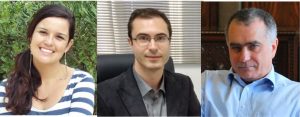
This study was funded by the Brazilian research agencies CAPES and CNPq, as the doctoral research of Virgínia Serra Souza at the Chemistry Institute of the Federal University of Rio Grande do Sul (IQ-UFRGS), under the guidance of Professor Jairton Dupont.
“The idea for this research came when we were looking for an alternative and efficient route for the synthesis of Ta2O5 nanoparticles, and after some experiments we decided to test the possibility of using ionic liquids as stabilizing sources and agents of the nanomaterials”, says Professor Jackson Damiani Scholten, who is one of the corresponding authors of the paper and member of the research group of IQ-UFRGS. This group has extensive experience in the study and development of ionic liquids (salts which are in liquid state at room temperature). Due to their physicochemical properties, ionic liquids can be used in the preparation of nanoparticles as stabilizers to keep the particles in the nanometric range.
Souza, Scholten and Dupont prepared two types of ionic liquids containing tantalum and create the conditions for the hydrolysis reaction (breaking the chemical bonds of a compound by the addition of water). The elements resulting from the hydrolysis, from the water and the ionic liquid, recombine to form tantalum oxide nanoparticles.
The team realized it had produced tantalum oxide nanoparticles ranging between 1.5 and 22 nm, the smaller ones had been generated from one of the ionic liquids and the larger ones from the other. With the assistance of Professor Daniel E. Weibel, also from IQ-UFRGS, they studied the surface composition of the nanoparticles. These scientists proposed that the nanoparticles obtained were hybrid: remains of ionic liquid were observed around the tantalum oxide.
To see how the nanoparticles behaved as catalysts in the separation of water molecules to generate hydrogen, the team conducted photocatalytic tests at the facilities of the Institute of Physics – UFRGS, provided by Professor Sérgio R. Teixeira. The tests were carried out in a solution that besides water contained ethanol – a compound that helps to increase the hydrogen production rate.
“We were delighted that the Ta2O5 nanoparticles showed one of the best results ever published for the production of H2 from a water/ethanol solution”, recalls Professor Scholten. In the article, this exceptional result was attributed to the presence of ionic liquid in the nanoparticles. “We believe that the residual ionic liquid enhances the formation of a hydrophilic regions on the surface of Ta2O5, favoring the approximation of polar molecules (water and ethanol)”, explains Scholten. To be certain about this, the scientists removed the ionic liquid from the nanoparticles by heat treatment and confirmed their very low photocatalytic activity.
In another stage of the research, Dario Eberhardt, then professor at the University of Caxias do Sul (UCS), collaborated with the team in the deposition of roughly 1 nm platinum nanoparticles on the surface of the hybrid tantalum oxide nanoparticles by the sputtering technique, carried out at IF-UFRGS. Professor Daniel L. Baptista, of IF-UFRGS, helped to characterize the material. In the tests, the performance of the tantalum oxide nanoparticles with photocatalytic ionic liquid was even better with the addition of platinum.
This work, carried out in southern Brazil, presented a new method to produce super-efficient catalysts for hydrogen production, a promising alternative fuel from water and ethanol, two renewable and abundant resources.
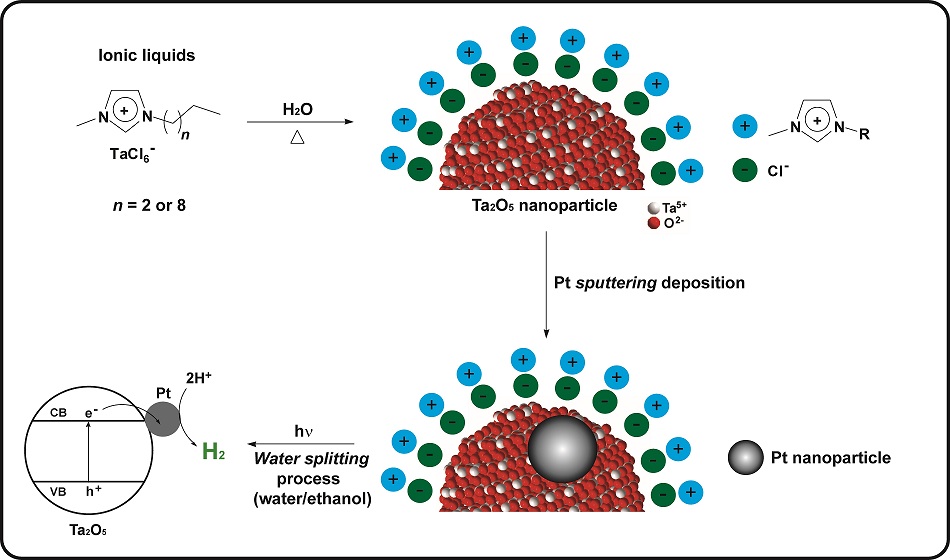
Interviews with plenary speakers of the XV Brazil-MRS Meeting: Ifor Samuel (University of S. Andrews, UK).
 Organic semiconductors are materials that combine useful properties of plastics (easy shaping, flexibility, low weight, low-cost processing) with the possibility of conducting electricity and emitting light. At the University of St Andrews, which lies since 1413 in a beautiful seaside location in Scotland (UK), Prof. Ifor Samuel converts his fascination for organic semiconductors into new materials, devices and applications.
Organic semiconductors are materials that combine useful properties of plastics (easy shaping, flexibility, low weight, low-cost processing) with the possibility of conducting electricity and emitting light. At the University of St Andrews, which lies since 1413 in a beautiful seaside location in Scotland (UK), Prof. Ifor Samuel converts his fascination for organic semiconductors into new materials, devices and applications.
Ifor Samuel received his MA and PhD diplomas from the University of Cambridge (England, UK), after working on optical spectroscopy of organic semiconductors. After his PhD, Samuel moved to Paris for two years to perform postdoctoral work at CNET-France Telecom, investigating the non-linear optical properties of organic materials. Back to England, he carried out research at Cambridge for a year, as research fellow at Christ’s College. After that, he set his own research group on light-emitting polymers at the University of Durham where he also held a Royal Society University Research Fellowship. In 2000 he joined the University of St Andrews, where he founded, in 2001, the Organic Semiconductor Centre, dedicated to interdisciplinary research on understanding and improving organic semiconductors and exploring their applications in the semiconductor, electronics and optoelectronics industries. In 2004 he founded the company Ambicare Health Ltd that produces wearable light sources for healthcare applications.
Ifor Samuel holds an H-index of 58. He has published more than 400 journal papers. His publications have more than 12,000 citations. He is a Fellow of the Royal Society of Edinburgh, the Institute of Physics, the International Society for Optics and Photonics (SPIE) and the Royal Society of Chemistry. Among other prizes, he won the Chemical Dynamics Award for 2016 of the Royal Society of Chemistry for his contributions to understanding light emission and fundamental photophysical processes in organic semiconductors.
At the University of St Andrews, Ifor Samuel is Professor of Physics, Director of the Organic Semiconductor Centre and head of the Organic Semiconductor Optoelectronics group. He is a member of the editorial board of the Journal of Photonics for Energy, and Editor-in-Chief of Synthetic Metals, a journal of electronic polymers and electronic molecular metals.
Here follows a short interview with Professor Ifor Samuel, who will be in Campinas (Brazil) at the end of September to talk about Organic Semiconductor Optoelectronics in a plenary lecture of the XV Brazil-MRS Meeting.
SBPMat newsletter: – In your opinion, what are your most significant scientific contributions to the organic semiconductors field? Explain them very briefly and, if possible, share references of resulting publications.
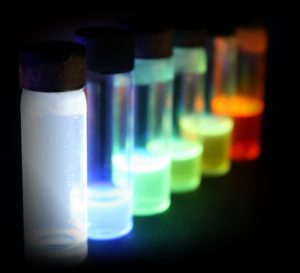
Ifor Samuel: – There have been two main themes to my research. One is understanding organic semiconductors with the aim of using that understanding to improve them. In this direction, I have studied the light emission process in conjugated polymers which is very important for organic light-emitting diodes (OLEDs) [1,2], developed as a new class of OLED material (with P.L. Burn) [3], and measured exciton diffusion which is very important in polymer solar cells [4].
The other major theme has been pushing the boundaries of devices and applications. Here, instead of developing new materials, I have been exploring what new things can be done with existing materials. For example, whilst nearly everybody was working on OLEDs for displays, I had a very interesting discussion with James Ferguson, head of dermatology at Ninewells Hospital in Dundee, leading to the development of wearable light sources for treatment of non-melanoma skin cancer [5]. More recently my team developed a wearable organic optoelectronic sensor for muscle contraction [6]. We have also been working with the Belgian Royal Military Academy on using conjugated polymer fluorescence and lasing for explosive detection for humanitarian demining. Recently we demonstrated (as part of a large project with collaborators in Edinburgh, Strathclyde and Oxford) the use of organic semiconductors for visible light communication, achieving record data rates for white visible light communication [7].
- Measurement of Absolute Photoluminescence Quantum Efficiencies in Conjugated Polymers. N.C. Greenham, I.D.W. Samuel, G.R. Hayes, R.T. Phillips, Y.A.R.R. Kessener, S.C. Moratti, and A.B. Holmes. Chem. Phys. Lett. 241, 89 (1995).
-
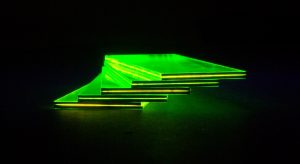
Fluorescent receiver for visible light communications. Efficient interchain photoluminescence in a high-electron-affinity conjugated polymer. I.D.W. Samuel, G. Rumbles and C.J. Collison. Physical Review B. 52, 11573 (1995).
- A green phosphorescent dendrimer for light-emitting diodes. S.C. Lo, N.A.H. Male, J.P.J. Markham, S.W. Magennis, P.L. Burn, O.V. Salata and I.D.W. Samuel. Adv. Mater. 14, 975 (2002).
- Determining the optimum morphology in high-performance polymer-fullerene organic photovoltaic cells. G.J. Hedley, A.J. Ward, A. Alekseev, C.T. Howells, E.R. Martins, L.A. Serrano, G. Cooke, A. Ruseckas and I.D.W. Samuel. Nature Comm. 4, 2867 (2013).
- An open pilot study of ambulatory photodynamic therapy using a wearable low-irradiance organic light-emitting diode light source in the treatment of nonmelanoma skin cancer. S.K. Attili, A. Lesar, A. McNeill, M. Camacho-Lopez, H. Moseley, S. Ibbotson, I.D.W. Samuel and J. Ferguson. Brit. J. Derm. 161, 170 (2009).
-

Conjugated polymer laser. Wearable organic optoelectronic sensors for medicine. A.K. Bansal, S.B. Hou, O. Kulyk, E.M. Bowman and I.D.W. Samuel. Adv. Mater. 27, 7638 (2015).
- Visible light communication using a blue GaN µLED and fluorescent polymer color converter. Chun, P.P. Manousiadis, S. Rajbhandari, D.A. Vithanage, G. Faulkner, D. Tsonev, J.J.D. McKendry, S. Videv, E.Y. Xie, E.D. Gu, M.D. Dawson, H. Haas, G.A. Turnbull, I.D.W. Samuel and D.C. O’Brien. IEEE Photonics Technology Letters 26, 2035 (2014).
SBPMat newsletter: – You have authored many patents. Are there products in the market based on our inventions?
Ifor Samuel: – The majority of my patents are licensed to companies that are developing them. There are several patents relating to light-emitting dendrimers as highly efficient solution-processed OLED materials. These were initially licensed to Opsys Ltd in Oxford, who were later acquired by Cambridge Display Technology, who in turn are now wholly owned by Sumitomo Chemical and incorporate aspects of the technology in their products. For the skin cancer treatment, the patents were licensed to the spin-out company Ambicare Health Ltd. Ambicare have brought two related products to market – one is a wearable red light source for skin cancer treatment, and the other is a wearable blue light source for acne treatment.
SBPMat newsletter: – The properties of organic semiconductors are different from those of inorganic semiconductors, leading to creation of novel devices. Could you give some examples of existing and not-yet invented devices based on organic semiconductors?
Ifor Samuel: – The advantages of organic semiconductors come from how they combine novel semiconducting optoelectronic properties with simple fabrication and the scope to tune properties by changing their structure. An existing organic semiconductor device is an OLED mobile phone display or television. They give very vivid images, together with outstanding contrast and viewing angle. However, in contrast to inorganic semiconductors which are rigid and brittle, organic semiconductors can be used to make flexible devices – such as light-emitting bandages for medicine. The flexibility has not yet been fully exploited, but also simplifies manufacture which could be by simple roll to roll processes. This would be an excellent way to make solar cells in Brazil. The laser explosive sensors are completely different from inorganic lasers because the explosive vapour binds to the gain medium and modifies its light emission.
SBPMat newsletter: – If you desire, leave an invitation for our readers to go to your plenary lecture at the XV Brazil-MRS Meeting.
Ifor Samuel: – I have really enjoyed my previous visits to the Brazil MRS meeting and look forward to visiting Campinas. Do come to my lecture to hear about the remarkable world of organic semiconductors and their applications.
Link to the abstract of Ifor Samuel´s plenary lecture at the XV Brazil-MRS Meeting: http://sbpmat.org.br/15encontro/speakers/abstracts/6.pdf
New journal: npj 2D Materials and Applications.
Aiming to create a top-tier interdisciplinary platform for scientists to share and promote 2D materials research and applications, npj 2D Materials and Applications is a new online-only, open access journal.
2D Materials and Applications is part of the Nature Partner Journals (npj) series, launched by Springer Nature as part of the Nature Research portfolio of journals, and published in partnership with the Faculdade de Ciências e Tecnologia da Universidade Nova de Lisboa (FCT Nova) with the support of the European Materials Research Society (E-MRS).
npj 2D Materials and Applications will publish original papers, review articles and short communications to reflect the latest breakthrough and developments taking place in all aspects of 2D materials, including allotropes (different structures of the same element) and compounds, ultralight composite materials, their properties (including mechanical properties), and their isolation, synthesis and manufacturing.
The journal will also publish research relating to the use of 2D materials in applications such as photovoltaics, optoelectronics and photonics, semiconductors, sensors, electrodes, water purification/filtration/distillation, and energy storage.
Led by Editor-in-Chief Professor Andras Kis, the journal is now open for submissions.
Visit the journal website to find out more: http://www.nature.com/npj2dmaterials/
SBPMat newsletter. English edition. Year 3, issue 6.
|
||||||||||||||||||||||||||||||||||
To unsubscribe, click here
Interviews with plenary speakers of the XV Brazil-MRS Meeting: Lei Jiang (Chinese Academy of Science, China).
 By studying spider webs, fish scales, lotus leaves and cactus, the Chinese scientist Lei Jiang (Technical Institute of Physics and Chemistry – Chinese Academy of Science) and his group have developed artificial systems that can be extremely useful for human being. For example, surfaces that exhibit superphobic or superphilic properties concerning water, oil and air. Professor Jiang´s surfaces and interfaces can also be intelligent and switch from superhydrophilicity to superhydrophobicity.
By studying spider webs, fish scales, lotus leaves and cactus, the Chinese scientist Lei Jiang (Technical Institute of Physics and Chemistry – Chinese Academy of Science) and his group have developed artificial systems that can be extremely useful for human being. For example, surfaces that exhibit superphobic or superphilic properties concerning water, oil and air. Professor Jiang´s surfaces and interfaces can also be intelligent and switch from superhydrophilicity to superhydrophobicity.
Prof. Jiang will come to Brazil at the end of September to present all these discoveries, and also the concept of “binary cooperative complementary nanomaterials” (BCCNMs), in a plenary lecture of the XV Brazil-MRS Meeting.
Lei Jiang obtained a B.S. in solid-state physics in 1987 and a M.S. in physical chemistry in 1990 from Jilin University of China. Then, he embraced doctoral studies in the same university. After a period in the University of Tokyo (Japan), he obtained his Ph.D. diploma in physical chemistry from Jilin University of China. From 1994 to 1996, he was postdoctoral fellow in the Akira Fujishima‘s group at Tokyo University of Science. Then, he remained in Japan as a researcher of Kanagawa Academy of Sciences and Technology. In 1999, he joined, as a Professor, the Institute of Chemistry at CAS. From 2004 to 2006, he also served as Chief Scientist of the National Center for Nanoscience and Technology of China.
Prof. Jiang (H index=92) is author of two books, 8 review papers and book chapters, and over 500 papers including articles in Nature, Nature Nanotechnology, Nature Materials, among many other high-impact journals. He holds dozens of granted patents and patent applications. His publications have been cited more than 38,000 times.
Lei Jiang is academician of CAS since 2009, foreign member of the US National Academy of Engineering since 2016, fellow of the Royal Society of Chemistry since 2010, and fellow of The World Academy of Sciences (TWAS) since 2012. Jiang acts in the boards of scientific journals Small, Advanced Functional Materials, Advanced Materials Interfaces, NPG Asia Materials, Journal of Inorganic Biochemistry and Materials Research Innovations. He has received many awards and honors granted by Chinese entities. His contributions have also been recognized with the TWAS Chemistry Award in 2011 and the MRS Mid-Career Researcher Award in 2014.
Here follows an interview with Professor Jiang.
SBPMat newsletter: – Explain in a few words your approach to learning from nature.
Lei Jiang: – We learn from nature mainly focusing on biological interfaces with superwettability, and then we investigated the correlation between the multiscale structures and superwettability. After that we design target molecules to prepare bioinspired functional materials with promising applications, such as self-cleaning coatings, water/oil separation, water collection, and energy conversion. Finally, by combining two complementary properties and achieving reversible switching between them, we were able to develop bioinspired smart interfacial materials with superwettability.
SBPMat newsletter: – Do you and your group perform nature observation by yourselves?
Lei Jiang: – Yes, we perform nature observation by ourselves.
SBPMat newsletter: – Do you search for specific plants or animals having in mind specific applications?
Lei Jiang: – Yes, we mainly focus on specific plants or animals with superwettability.
SBPMat newsletter: – Do you work in collaboration with biologists and materials engineers from other groups to understand nature and produce the artificial materials systems?
Lei Jiang: – Yes, we always work in collaboration with other groups, who are focused on materials, mechanics, biology etc., to understand nature and produce the artificial materials systems.
SBPMat newsletter: – Are there products in the market, or almost there, based on your discoveries? How were they created (through patent licensing, spinoff companies, joint development)?
Lei Jiang: – We have transferred several research findings in the laboratory to practical products in the market. Until now, we have cofounded 3 technology companies. As one of the very first commercially available bioinspired material produced in large scale, our superhydrophilic coatings have been applied to landmark buildings such as the China National Grand Theatre, and the Beijing International Airport. Our oil/water separation system has also been applied to more than 630 ships travelling around the world. Based on the materials with special wettability, a bioinspired green printing technology is also currently being used to print newspapers by many publishers.
SBPMat newsletter: – To those readers who may be very curious about your concept of “binary cooperative complementary nanomaterials”, please say a couple of words about it. Is there a philosophical idea behind that concept?
Lei Jiang: – Binary cooperative complementary materials, consisting of two components with entirely opposite physiochemical properties at the nanoscale, are presented as a novel principle for the design and construct of functional materials. By summarizing recent achievement in materials science, it can be found that the cooperative interaction distance between the pair of complementary properties must be comparable with the scale of related physical or chemical parameter. When the binary components are in the cooperative distance, the cooperation between these building blocks becomes dominant and endows the macroscopic materials with unique properties and advanced functionalities that cannot be achieved by either of building blocks. The law of unity and interpenetration of opposites was proposed in “Dialectics of Nature,” an unfinished 1883 work by Friedrich Engels. He stated “Everywhere we look in nature, we see the dynamic co-existence of opposing tendencies. This creative tension is what gives life and motion.” Dialectic was derived from the works of philosophers G. W. F. Hegel (1831) and Heraclitus (500 BC), who thought that everything was constantly changing and that all things consisted of two opposite elements that could change into each other. Ancient Chinese philosophers also utilized “Yin” and “Yang” as two basic polarities of the universe to interpret the binary cooperative complementary phenomenon in nature and the universe. However, Engels simply thought the idea of “Yin” and “Yang” was just an embryo of dialectics in ancient China. However, Chinese philosophers had already studied the evolution process and unity of two opposite elements quantitatively. For example, “I Ching” (1000–750 BC), an ancient Chinese book of changes, stated that 64 Yin-Yang combinations known as “64-gua” are possible with hexagrams (patterns of 6 broken and unbroken lines).
Please find the details about “binary cooperative complementary materials” in ” Science China Materials, 2016, 59, 239–246, http://link.springer.com/
——————-
Link to the abstract of the XV Brazil-MRS Meeting plenary talk “Smart Interfacial Materials from Super-Wettability to Binary Cooperative Complementary Systems”: http://sbpmat.org.br/
2016 Kavli Prize 2016 – nanoscience awarded to the inventors of the atomic force microscope.

In the 2016 edition, the Kavli Prize – nanoscience was awarded to the three scientists who invented the atomic force microscope (AFM): Gerd Binnig (IBM Zurich Research Laboratory, Switzerland), Christoph Gerber (University of Basel, Switzerland) and Calvin Quate (Stanford University, USA). The Kavli Prize has been awarded since 2008 in the fields of Astrophysics, Nanoscience and Neuroscience by the Kavli Foundation, the Norwegian Academy of Science and Letters and the Norwegian Ministry of Education and Research.
The atomic force microscope (AFM), created in the mid-1980s, was the first instrument that made possible viewing details of different kinds of materials with a resolution of less than a nanometer (on the order of angstroms). More recently, this instrument has also been used to manipulate surfaces with atomic precision, in which atoms can be pushed, pulled or slid on a surface, one by one, with the tip of the microscope.

According to the Kavli Prize website, the history of the atomic force microscope goes back to 1981 when the German physicist Gerd Binnig, along with Heinrich Rohrer and collaborators invented the scanning tunneling microscope (STM) in the IBM labs in Zürich (Switzerland). That was the first instrument that showed the composition of materials on the nanoscale, with a resolution of a few nanometers. The STM, however, had a serious limitation: it could only be used to image conductive materials. So Binnig thought about the changes he could make on the microscope that would overcome this obstacle.
In 1985 he filed the patent application of the AFM, which could produce images of samples of all kinds. He then summoned two scientists he had worked with in the development of the STM (Gerber and Quate). Together they set up the first AFM and conducted the first experiments, whose results were published in the journal Physical Review Letters in March 1986.
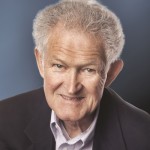
After three decades developing the technique and the instrument, the atomic force microscopy has now several new modes to use it, new spin-off instruments and new fields of application (including the Life Sciences).
More information on the AFM and its inventors is available in the Kavli Prize website: http://www.kavliprize.org/prizes-and-laureates/prizes/2016-kavli-prize-nanoscience
Professor Fernando Lázaro Freire Junior, former president of SBPMat, became the director of the Physics Department of PUC-Rio.
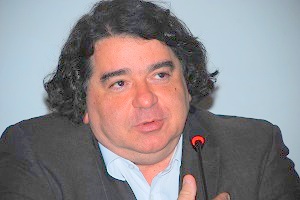
Professor Fernando Lázaro Freire Junior, a participatory member of SBPMat since its creation, took over as director of the Physics Department at the Pontifical Catholic University of Rio de Janeiro (PUC-Rio) in an inauguration ceremony held on May 31 of this year.
With an undergraduate degree, a master’s and doctorate in Physics from PUC-Rio, Freire Junior began teaching at that university in 1979. In 1985, he became an assistant professor and, in 2012, a full professor. From 2003 to 2008 he was director of the Physics Department of the university, a post he occupies again this year. Between 2011 and 2015, he served as director of the Brazilian Center for Research in Physics (CBPF).
In SBPMat, Fernando Lázaro Freire Junior was a member of the founding board (2001), scientific director from 2004 to 2005, president for two consecutive terms from 2006 to 2009 and financial director from 2012 to 2013, among other activities.
See the news story about Professor Freire Junior appointed as the director of the Physics Department in the website of PUC-Rio: http://jornaldapuc.vrc.puc-
